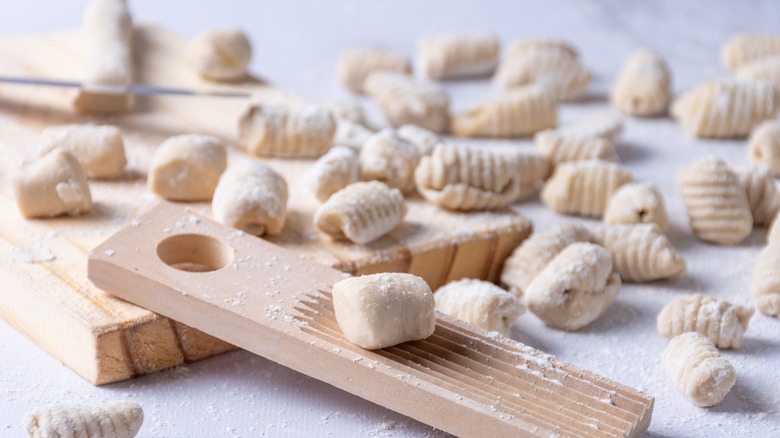You Don't Need Ricotta For Gnocchi When There's A Simple Substitute
Cottage cheese, a soft, curd-laden cheese made with cow's milk, has made a surprising comeback, especially among foodies looking to up their protein intake. Just as Greek yogurt makes for a protein-packed sour cream swap, cottage cheese, which is ripe with casein protein, is a long-digesting, muscle-building alternative to heavy creams and cheeses. Cottage cheese is an excellent swap for heavy cream in creamy Alfredo sauce, a great replacement for cream cheese in spinach and artichoke dip, and a particularly excellent dupe for ricotta in many Italian recipes like lasagna and gnocchi.
Ricotta and cottage cheese share many similarities: they're both fresh, soft, and white, and are of a similar enough consistency that they can be swapped in one-to-one amounts. For an even closer approximation, you'll want to strain your cottage cheese before swapping. It's also important to note that cottage cheese is a little saltier than ricotta, so watch the salt elsewhere in your recipes.
Swapping cottage cheese for ricotta in gnocchi
Traditional gnocchi doesn't actually call for any cheese, just flour, eggs, and potatoes. But if you've made gnocchi at home (or attempted it) you know that they can be fussy. The potatoes need to be riced, the dough kneaded, and even with careful preparation your results might end up a little gluey. That's why many chefs at home and in restaurants have brought ricotta into the equation. The cheese helps to bind the ingredients alongside the eggs, and also adds enough richness and texture that you can leave the potatoes out entirely if you so choose.
By removing potatoes from the equation and swapping in cottage cheese for ricotta, your once-decadent gnocchi dish transforms into a protein powerhouse. Although a low-fat cottage cheese will, of course, be lower in fat, a full fat cottage cheese will add more ricotta-esque flavor. Small-curd cottage cheese will mix into a dough more smoothly. Finally, a step that isn't always necessary for ricotta is essential here: Spend a few minutes draining your cottage cheese before mixing it into your dough. For gnocchi, this is best accomplished by straining your cottage cheese then setting it on a baking sheet between a few layers of paper towels for at least 15 minutes. This quickly removes excess liquid and ensures you're getting as close to the consistency of ricotta as possible. Top your cottage cheese gnocchi with a bright pesto or zippy lemon sauce for a flavorful, healthy, delicious dinner.

